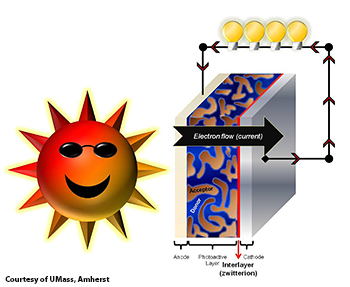
A layer of zwitterionic fullerenes could allow the use of any type of metal electrode for a more efficient, lightweight and low-cost organic solar cell.
Photovoltaic engineers can’t have it all—they often have to choose between work function and stability when choosing metal electrodes for organic solar cells. Metals that are resistant to oxidation often don’t transfer electrons well. Conversely, metals that are great at transferring electrons degrade quickly. Researchers from the University of Massachusetts, Amherst, USA, are engineering new materials with zwitterions and fullerenes (aka “buckyballs”) to create efficient solar cells that can use almost any metal as an electrode (Science, doi: 10.1126/science.1255826).
Work function refers to the level of difficulty in transferring electrons from a solar cell’s photoactive layer to the metal electrode; a low work function means easier electron transport. To lower the work function of stable but not particularly conductive metals like silver, copper and gold, Todd Emrick and his colleagues synthesized polymers that can act as a buffer between the photoactive and electrode layers of an organic solar cell, easing electron movement. These conjugated polymers contain zwitterions—neutral molecules that have both a positive and negative charge and strong dipoles that interact with the metal electrodes. However, these zwitterion buffer layers need to be very thin—between 5 and 10 nanometers—to work efficiently. Layers this thin could be very difficult to manufacture.
To solve this issue, the team turned to fullerenes, which are commonly found in the photoactive layer of solar cells because of their ability to aid electron transport. They combined fullerenes with their conjugated polymer zwitterions and sandwiched the material between the solar cell’s photoactive layer and metal electrode. When tested, they found that this layer could function effectively at thicknesses ranging from 5 to 55 nanometers, thereby eliminating thin-film manufacturing concerns. The authors believe that this technology could be applied to other organic electronic devices.

